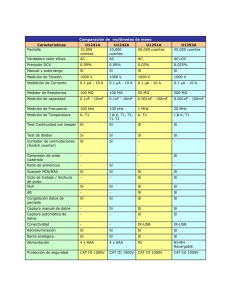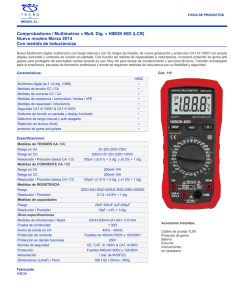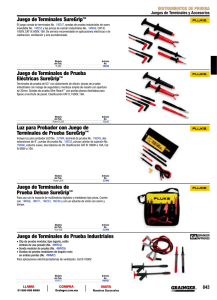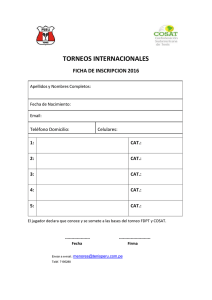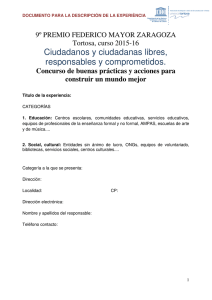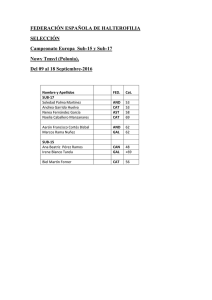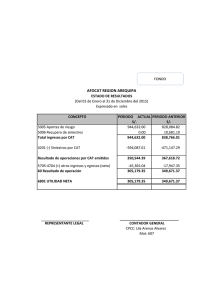Untitled - Southwire Tools
Anuncio
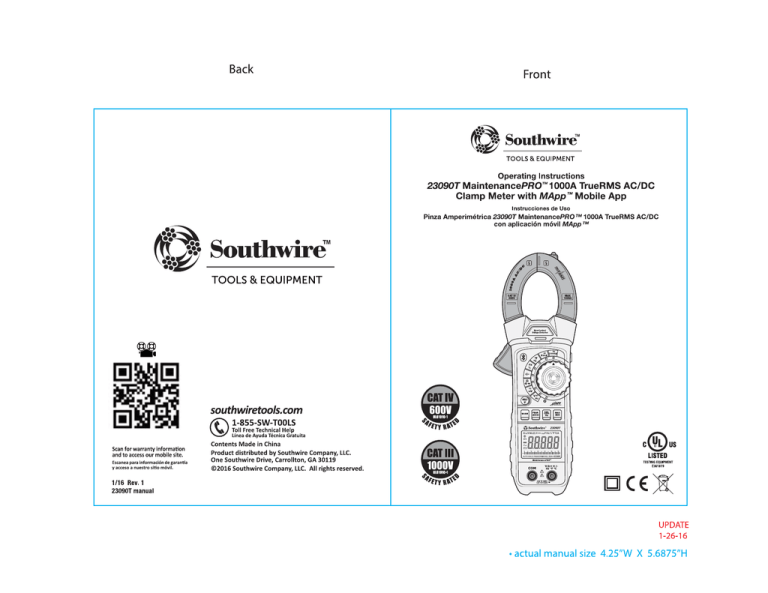
Input Limits Especificaciones cont. Function Función Rango Resolución Precisión ± (% de lectura + dígitos) Ciclo de Trabajo 5.0% a 95.0% 0.1% ±(1.0% +2 dígitos) Protección de Entrada: Ancho del Pulso: Frecuencia: Sensibilidad: 600V DC o 600V AC rms 100µS a 100 mS 10 Hz a 10 kHz >5V RMS Frecuencia y Ciclo de Trabajo a través de los cables de prueba cuando el medidor está ajustado a la voltaje AC Función Rango Precisión ± (% de lectura + dígitos) 40Hz a 1kHz Frecuencia 20% a 80% Protección de Entrada: Rango de frecuencia: Sensibilidad: 40Hz a 1kHz ±(1.0% ±5 dígitos) Ciclo de Trabajo 20% a 80% ±(1.5% ±10 dígitos) (Rango Automático) Temperatura 1000V AC rms o 1000V DC 40 Hz a 1 kHz >15V RMS -148.0° a 1832.0°F -100.0° a 1000.0°C Protección de Entrada: Sensor: Resolución 0.1°F 0.1°C 600V AC rms o 600V DC Tipo K Termopar 18 span. Insulated Tip On CAT III 1000V CAT IV 600V ±(1.5% ±10 dígitos) 1000V AC rms o 1000V DC 40Hz a 1kHz >15V RMS Rango WARNING: Operation of meter and test leads is limited to CAT II 1000V when the insulated tip is removed from the test probes. General Specifications Frecuencia Función 600V AC/DC Test Leads Frecuencia y Ciclo de Trabajo a través de las pinzas cuando el medidor está ajustado a la corriente AC Función Rango Precisión ± (% de lectura + dígitos) Protección de Entrada: Rango de frecuencia: Sensibilidad: Maximum Input 1000A AC/DC 1000V AC/DC 600V AC/DC ±(1.0% ±5 dígitos) (Rango Automático) Ciclo de Trabajo Amperage AC/DC Voltage AC/DC Frequency, Duty Cycle, Resistance, Diode Test, Continuity, Capacitance Temperature (°C/°F) Precisión ± (% de lectura + dígitos) ±(1% + 4.5°F) ±(1% +2.5°C) Clamp jaw opening Diode Test Continuity Test Low Battery Indication Display Over Range Indication Measurement Rate Input Impedance Operating Temperature Storage Temperature Operating Humidity Storage Humidity Operating Altitude Battery Auto Power Off Dimensions/Weight Safety Insulated Tip Removed CAT II 1000V 1.9” (48mm) Test current of 0.3mA typical; Open circuit voltage < 2V DC typical Threshold <50Ω ± 5Ω , Test current <0.5mA is displayed 50,000 count backlit LCD “OL” is displayed 3 readings per second, nominal 10MΩ (VAC and VDC) 41° to 104°F (5° to 40°C) -4° to 140°F (-20° to 60°C) Max 80% up to 87°F (31°C) decreasing linearly to 50% at 104°F (40°C) <80% 7000ft (2000 meters) maximum One 9V Battery After approx. 30 minutes 9” x 3” x 1.6” (230 x 76 x 40mm) / 0.69lb (315g) Complies with UL 61010-1 3rd edition for measurement CAT IV 600V, CAT lll 1000V, Pollution Degree 2 2 Maintenance Especificaciones Función Corriente AC Rango Resolución Precisión ± (% de lectura + dígitos) 500.00A 1000.0A 10mA 0.1A ±(2.5% +5 dígitos) Entrada Máxima: 1000A AC rms o DC 1000A Ancho de banda actual AC: 50 a 60 Hz Corriente AC actual se especifica desde 5% a 100% del rango. Función Corriente DC Entrada Máxima: Función AC mV Voltaje AC Rango Automático Rango Resolución Precisión ± (% de lectura + dígitos) 500.00A 1000.0A 10mA 0.1A ±(2.5% +5 dígitos) 1000A AC rms o DC 1000A Rango Resolución 500.00mV 5.0000V 50.000V 500.00V 1000.0V 0.01mV 0.1mV 1mV 10mV 0.1V Precisión ± (% de lectura + dígitos) This Clamp Meter is designed to provide years of dependable service, if the following care instructions are performed: 1. KEEP THE METER DRY. If it gets wet, wipe it off. 2. USE AND STORE THE METER IN NORMAL TEMPERATURES. Temperature extremes can shorten the life of the electronic parts and distort or melt plastic parts. 3. HANDLE THE METER GENTLY AND CAREFULLY. Dropping it can damage the electronic parts or the case. 4. KEEP THE METER CLEAN. Wipe the case occasionally with a damp cloth. DO NOT use chemicals, cleaning solvents, or detergents. 5. USE ONLY FRESH BATTERIES OF THE RECOMMENDED SIZE AND TYPE. Remove old or weak batteries so they do not leak and damage the unit. 6. IF THE METER IS TO BE STORED FOR A LONG PERIOD OF TIME, the battery should be removed to prevent damage to the unit. ±(1.0% +30 dígitos) ±(3.0% +8 dígitos) Protección de Entrada 500mV: 600V AC rms o 600V DC Protección de Entrada 5V/50/500/1000V: 1000V AC rms o 1000V DC Ancho de banda de voltaje AC: 50 a 1000 Hz Voltaje AC actual se especifica desde 5% a 100% del rango. Función DC mV Voltaje DC Rango Automático Rango Resolución 500.00mV 5.0000V 50.000V 500.00V 1000.0V 0.01mV 0.1mV 1mV 10mV 0.1V Protección de Entrada 500mV: Protección de Entrada 5V/50/500/1000V: Precisión ± (% de lectura + dígitos) ±(1.0% +8 dígitos) ±(1.5% +3 dígitos) 600V AC rms o 600 V DC 1000V AC rms o 1000 V DC 16 Span. 4 Operación cont. Meter Description 1. 1. Non-contact voltage detector 2. Current clamp 3. LED flashlight 4. Non-contact AC voltage indicator 5. Bluetooth/Flashlight On/Off button 6. Clamp trigger 7. Rotary function switch 8. Data HOLD/Backlight button 9. MODE select button 10. MAX /MIN button 11. PEAK /INRUSH button 12. REL /Hz button 13. LCD display 14.COM input jack 15. V Hz% °F/°C input jack ADVERTENCIAS: Para evitar descargas eléctricas, retire los cables de prueba del medidor antes de retirar la tapa de la batería. 2. 3. 4. 6. 5. 7. 8. 9. 11. Cambio de Batería 10. 12. 1. Cuando la batería se agote, el símbolo aparecerá en la pantalla LCD. Reemplace la batería inmediatamente. 2. Utilice un pequeño destornillador de punta plana para aflojar el tornillo. 3. Retire la cubierta de la batería. 4. Reemplace la batería tornillo con una batería de 9 voltios. 5. Instale la cubierta de la batería y apriete el tornillo. ADVERTENCIAS: Para evitar descargas eléctricas, no opere el medidor hasta que la cubierta de la batería esté bien asegurada al medidor. 13. 14. 5 15. 15 Span. Operación cont. Mediciones de Temperatura ADVERTENCIAS: No toque circuitos activos con la sonda de temperatura. 1. Coloque el interruptor de función rotativa en la posición °F °C. 2. Conecte la Sonda de Temperatura al Adaptador tipo Banana. Tenga en cuenta las marcas - y + en el adaptador. Conecte el adaptador al metro, asegurándose de que el lado - entre en la toma de entrada COM y el lado + entre en la toma de entrada °F °C. 3. Pulse el botón MODE para seleccionar lecturas en °F o °C. 4. Toque el objeto que se está midiendo con la punta de la Sonda de Temperatura. Mantenga la sonda tocando el objeto hasta que se estabilice la lectura (aproximadamente 30 segundos). 5. Lea la temperatura en la pantalla LCD. ADVERTENCIAS: Para evitar descargas eléctricas, retire la sonda de temperatura antes de cambiar a otra función de medición. Detector de Voltaje AC Sin Contacto (110 a 1000V AC) ADVERTENCIAS: Riesgo de electrocución. Antes de usar, pruebe siempre el detector del voltaje en un circuito activo conocido para verificar el funcionamiento correcto. 1. El detector de tensión sin contacto funciona cuando el medidor está ajustado a cualquier función de medición. El detector no funciona cuando el apagado automático apaga el medidor o cuando el interruptor de función rotativa está ajustado a la posición de apagado . 2. Mueva lentamente la sonda detectora más cerca del conductor que está probando. 3. Si el voltaje AC dentro del rango especificado está presente, la luz indicadora se encenderá. ADVERTENCIAS: El tipo de aislamiento y el espesor, la distancia desde la fuente de voltaje y otros factores pueden afectar el funcionamiento. Utilice otros métodos para verificar el voltaje activo si hay alguna incertidumbre. NOTEA: El detector está diseñado con una alta sensibilidad. La electricidad estática y otras fuentes de energía eléctrica pueden activar aleatoriamente el detector. Esta es una operación normal. El detector sólo activa la luz indicadora cuando el voltaje AC está presente. No indica el nivel de voltaje en la pantalla. 14 Span. Symbols Used on LCD Display V A ~ - F Hz % °F °C n µ m k M OL AUTO HOLD MAX/MIN PMAX/PMIN REL INRUSH Volts Amperes Alternating current Direct current Minus sign Ohms Bluetooth® Continuity Diode test Farads (capacitance) Hertz (frequency) Percent (duty ratio) Degrees Fahrenheit Degrees Celsius nano (10-9) micro (10-6) milli (10-3) kilo (103) mega (106) Overload Auto Power Off Low battery Autoranging Display hold Maximum/Minimum Peak Maximum /Peak Minimum Relative Inrush current 6 Operación cont. Operation HOLD/Backlight Button To freeze the reading on the LCD display, momentarily press the HOLD button. The “HOLD” indicator will be displayed while the reading is being held. Momentarily press the HOLD button again to return to normal operation. The backlight illuminates the display when the ambient light is too low to view the readings. To turn the backlight on or off, press the HOLD button until the backlight turns on or off. NOTE: The backlight stays on for approximately 30 seconds when the meter is initially turned on. MODE BUTTON The MODE button is used to select AC or DC when the meter is set to voltage or current, to select Resistance, Diode Test or Continuity when set to ohms, to select °F or °C when set to temperature, and to select Hz or % Duty Cycle when set to frequency. PEAK/INRUSH Button The PEAK function captures the highest positive and highest negative peak on an AC voltage or AC current waveform. The readings will update every time a higher positive or negative peak is detected. To activate, press and hold the PEAK/INRUSH button for approximately 2 seconds. The “PMAX” indicator will appear on the LCD display along with the highest positive peak. To view the negative peak, momentarily press the PEAK/INRUSH button. The “PMIN” indicator will appear along with the highest negative peak. Momentarily press the PEAK/INRUSH button to return to PMAX. To return to normal operation, press and hold the PEAK/INRUSH button until the “AUTO” indicator appears on the LCD display. The INRUSH function is used to calculate the startup current over a 100mS time period. This is useful for capturing current surges when motors and other devices are initially energized. To measure INRUSH current, momentarily press the PEAK/INRUSH button when the device being tested is powered off. The “INRUSH” indicator will appear on the LCD display. As soon as power is applied, the meter will display and hold the INRUSH current reading. To return to normal operation, momentarily press the PEAK/INRUSH button. 7 Prueba de Capacitancia ADVERTENCIAS: Descargue con cuidado los capacitores antes de tomar medidas de capacitancia. Non-Contact Voltage Detector 1. Coloque el interruptor de función rotativa en la posición . 2. Inserte el cable de prueba negro en la toma de entrada COM y el cable de prueba rojo en la toma de entrada . 3. Toque el capacitor bajo prueba con las sondas de los cables de prueba. 4. Lea el valor de capacitancia en la pantalla LCD. Puede tomar hasta un minuto para obtener una lectura estable 23090T en capacitores grandes. 500A 1000A AUTO POWER OFF MODE PEAK INRUSH REL Hz MAX MIN Mediciones de Frecuencia y Ciclo de Trabajo ADVERTENCIAS: Siga todas las precauciones de seguridad al trabajar con voltajes activos. 1. Coloque el interruptor de función rotativa en la posición Hz. 2. Pulse el botón MODE para seleccionar la Frecuencia (Hz) o el Ciclo de Trabajo (%). "Hz" o "%" aparecerá en la pantalla LCD. 3. Inserte el cable de prueba negro en la toma de entrada COM y el cable de prueba rojo en la toma de entrada HZ %. 4. Toque el circuito que se está probando con las sondas de los cables de prueba. 5. Lea la frecuencia o el ciclo de trabajo en la pantalla LCD. 6. Para medir la frecuencia cuando esté en el voltaje AC o en la función de corriente AC, mantenga pulsado el botón REL/Hz hasta que el indicador "Hz" aparezca en la pantalla LCD. Para medir el Ciclo de Trabajo, pulse y mantenga pulsado el botón REL/Hz una segunda vez hasta que aparezca el indicador "%". Las mediciones se realizarán a través de los cables de prueba cuando el medidor esté configurado a voltaje AC y a través de las pinzas cuando el medidor está configurado en corriente AC. Para salir del Ciclo de Trabajo, mantenga pulsado el botón REL/HZ hasta que el medidor vuelva al voltaje o a las lecturas actuales. Consulte las especificaciones en el manual para el rango de frecuencia y la sensibilidad. Data Logging Clamp Meter CAT IV 600V CAT III 1000V 13 Span. Operation cont. Operación cont. Prueba de Continuidad ADVERTENCIAS: Nunca pruebe la continuidad en un circuito activo. 1. Coloque el interruptor de función rotativa a la posición 2. Pulse el botón MODE hasta que el símbolo de aparezca en la pantalla. 3. Inserte el cable de prueba negro en la toma de entrada COM y el cable de prueba rojo en la toma de entrada Ω. 4. Toque el dispositivo o cable bajo prueba con las sondas de los cables de prueba. 5. Una señal acústica sonará si la resistencia es de aproximadamente 50 ohmios o menos y el valor de la resistencia se mostrará en la pantalla LCD. Non-Contact Voltage Detector 500A 1000A AUTO POWER OFF MODE PEAK INRUSH REL Hz MAX MIN 23090T . REL/HZ Button The RELATIVE function zeros out the reading on the display and stores it as a reference. Subsequent readings will be displayed as the relative difference between the actual measurement and the stored reference value. To activate, momentarily press the REL/Hz button. The “REL” indicator will appear on the LCD display along with the relative reading. Momentarily press the REL/HZ button again to return to normal operation. To select Frequency when the meter is set to AC Voltage or AC Current, press and hold the REL/HZ button until the “Hz” indicator appears on the LCD display. To display Duty Cycle, press and hold the REL/HZ button again until the “%” indicator appears on the LCD display. While displaying % Duty Cycle, press and hold the REL/HZ button to return to voltage or current readings. MAX/MIN Button The MAX/MIN function displays the highest and lowest measurements. The readings are updated every time a higher or lower measurement is captured. To activate, momentarily press the MAX/MIN button. “MAX” will appear on the LCD display along with the highest reading. Momentarily press the MAX/MIN button to sequence the meter from MAX to MIN, from MIN to the actual reading, and from the actual reading back to MAX. “MIN” will appear when the lowest reading is displayed and “MAX MIN” will appear when the actual reading is displayed. Press and hold the MAX/MIN button to end MAX/MIN and return to normal operation. (MAX/MIN does not operate on Resistance, Continuity, or Capacitance) Bluetooth® / Flashlight Button Bluetooth® allows readings to be displayed and stored on mobile devices. To activate Bluetooth®, press and hold the blue button on the side of the meter until the symbol appears on the LCD display. Bluetooth® should be disabled when not connected to a mobile device in order to conserve battery power. To turn off Bluetooth®, press and hold the blue button until the symbol no longer appears on the display. Data Logging Clamp Meter Visit nextgenmeters.southwire.com for mobile app download information. CAT IV 600V CAT III 1000V To turn the Flashlight on, momentarily press the blue button on the side of the meter. Momentarily press the blue button again to turn the flashlight off. The Bluetooth® word mark and logos are registered trademarks owned by Bluetooth SIG, Inc. and any use of such marks by Southwire Company, LLC. is under license. Other trademarks and trade names are those of their respective owners. 12 Span. 8 Operation cont. Auto Power Off Operación cont. To conserve battery power, the meter automatically turns off after approximately 30 minutes. To reset the meter after it turns off, set the rotary function switch to the off position and then set the switch to the desired function. To disable Auto Power Off, set the rotary function switch to the Off position. Press and hold the MODE button while setting the rotary function switch to the desired function. APO d will appear on the LCD display indicating Auto Power Off is disabled. Release the MODE button. The symbol will not be displayed while Auto Power Off is disabled. Auto Power Off can be restored by turning the meter off. As soon as the meter is turned back on, the symbol will reappear on the LCD display indicating Auto Power Off is active. AC/DC Current Measurements WARNINGS: Disconnect the test leads and temperature probe from the meter before making current clamp measurements. Do not measure current on conductors that are more than 600V above earth ground if in a CAT IV application or more than 1000V above earth ground if in a CAT lll application. Observe safety precautions when working on live circuits. 1. Set the rotary function switch to the 500A or 1000A position. 2. If the range is not known, select the higher range first, and then move tothe lower range if necessary. 3. Select AC (~) or DC ( ) by pressing the MODE button. In the DC mode, allow time for the meter to Zero before taking a measurement. If necessary, press the REL/Hz button to Zero out any DC offset. Zeroing the meter is not necessary when measuring AC current. 4. Press the trigger to open the jaw. Clamp around a single conductor making sure the jaws are fully closed before taking a measurement. For best results, keep the conductor centered inside the jaw. 5. Read the current on the LCD display. CAT IV 600V MODE PEAK INRUSH REL Hz CAT IV 600V CAT IV 600V CAT III 1000V 9 MODE MAX 1000A 500A MAX MIN Incorrect Non-Contact Voltage Detector Non-Contact Voltage Detector 1000A 23090T 1. Coloque el interruptor de función rotativa en la posición . 2. Presione el botón MODE hasta que el símbolo aparezca en la pantalla. 3. Inserte el cable de prueba negro en la toma de entrada COM y el cable de prueba rojo en la toma de entrada Ω. 4. Toque el diodo bajo prueba con las sondas de los cables de prueba. 5. El voltaje delantero indicará 0.4 a 0.7 en la pantalla LCD. El voltaje inverso indicará "OL". Los dispositivos en corto indicarán cerca de 0V y un dispositivo abierto Sonda Sonda Sonda indicará "OL" en ambas polaridades. Roja Negra Negra PEAK INRUSH 500A MODE PEAK INRUSH REL Hz YES 1000A MAX MIN 23090T CAT IV 600V CAT III 1000V Correct 11 Span. 1000A AUTO POWER OFF REL Hz MAX MIN 23090T Sonda Roja Prueba Inversa Data Logging Clamp Meter CAT IV 600V CAT III 1000V MAX 1000A NO ADVERTENCIAS: Nunca pruebe los diodos en un circuito activo. Prueba Delantera Non-Contact Voltage Detector 500A Prueba de Diodo Operation cont. Operación cont. Mediciones de Voltaje AC /DC AC/DC Voltage Measurements ADVERTENCIAS: Siga todas las precauciones de seguridad al trabajar con voltajes activos. CAT IV 600V MAX 1000A Non-Contact Voltage Detector 500A Non-Contact Voltage Detector 1000A 1000A REL Hz PEAK INRUSH MODE PEAK INRUSH REL Hz MAX MIN 23090T CAT IV 600V CAT III 1000V MODE V Resistance Measurements CAT IV 600V CAT III 1000V CAT IV 600V MAX 1000A Non-Contact Voltage Detector Non-Contact Voltage Detector 1000A MODE 10 INRUSH REL Hz Data Logging Clamp Meter CAT IV 600V CAT III 1000V Span. MAX MIN PEAK INRUSH REL Hz MAX MIN 23090T REL Hz PEAK INRUSH MAX MIN CAT IV 600V CAT III 1000V V CAT IV 600V CAT III 1000V WARNING: Never test resistance on a live circuit. CAT IV 600V MAX 1000A Non-Contact Voltage Detector 500A MODE PEAK INRUSH REL Hz 1000A MAX MIN 23090T AUTO POWER OFF PEAK MODE Data Logging Clamp Meter ADVERTENCIAS: Nunca pruebe la resistencia en un 500A 1000A 23090T Data Logging Clamp Meter 1. Coloque el interruptor de función rotativa en la posición Ω •))) . 2. Pulse el botón MODE hasta que aparezca el símbolo "Ω" en la pantalla. 3. Inserte el cable de prueba negro en la toma de entrada COM y el cable de prueba rojo en la toma de entrada Ω. 4. Toque el componente bajo prueba con las sondas de los cables de prueba. Si el componente se instala en un circuito, es mejor desconectar un lado antes de la prueba para eliminar la interferencia23090T de otros dispositivos. 5. Lea la resistencia en la pantalla LCD. 500A 1000A AUTO POWER OFF MAX MIN circuito activo. 1. For voltage measurements up to 1000V, set the rotary function switch to the V position. For measurements 500mV or less, set the rotary function switch to the mV position. 2. Select AC (~) or DC ( ) by pressing the MODE button. 3. Insert the black test lead into the COM input jack and the red test lead into the V input jack. Touch the test lead probes to the circuit under test. For DC measurements, Touch the red test lead to the positive side of the circuit and the black test lead to the negative side of the circuit. 4. Read the voltage on the LCD display. 500A 23090T Mediciones de Resistencia MAX 1000A Non-Contact Voltage Detector AUTO POWER OFF MODE CAT IV 600V Non-Contact Voltage Detector 1. Para las mediciones de voltaje de hasta 1000V, ajuste el interruptor de función rotativa en la posición V. Para las mediciones de 500mV o menos, ajuste el selector de función en la posición mV. 2. Seleccione AC (~) o DC ( ) pulsando el botón MODE. 3. Inserte el cable de prueba negro en la toma de entrada COM y el cable de prueba rojo en la toma de entrada V. Toque al circuito bajo prueba con las sondas de los cables de prueba. Para mediciones de corriente continua, toque el lado positivo del circuito con el cable de prueba rojo y el lado negativo del circuito con el cable de prueba negro. 4. Lea el voltaje en la pantalla LCD. 500A WARNING: Observe all safety precautions when working on live voltages. 1. Set the rotary function switch to the Ω •))) position. 2. Press the MODE button until the “Ω” symbol appears on the display. 3. Insert the black test lead into the COM input jack and the red test lead into the Ω input jack. 4. Touch the test lead probes to the component under test. If the component is installed in a circuit, it is best to disconnect one side before testing to eliminate interference from other devices. 23090T 5. Read the resistance on the LCD display. 500A Non-Contact Voltage Detector 1000A 500A MODE PEAK INRUSH REL Hz Ω MODE 10 PEAK INRUSH REL Hz MAX MIN CAT IV 600V CAT III 1000V Ω Data Logging Clamp Meter CAT IV 600V CAT III 1000V MAX MIN 23090T AUTO POWER OFF CAT IV 600V CAT III 1000V 1000A Operación cont. Operation cont. Apagado Automático Diode Test WARNING: Never test diodes in a live circuit. Non-Contact Voltage Detector 1. Set the rotary function switch to the position. 2. Press the MODE button until the symbol appears on the display. 3. Insert the black test lead into the COM input jack and the red test lead into the Ω input jack. 4. Touch the test lead probes to the diode under test. 5. Forward voltage will indicate 0.4V to 0.7V on the LCD display. Reverse voltage will indicate “OL”. Shorted devices will indicate near 0V and an open Red Black Black device will indicate “OL” in both Probe Probe Probe polarities. MODE Forward test PEAK INRUSH 500A 1000A AUTO POWER OFF REL Hz MAX MIN 23090T Red Probe Reverse test Data Logging Clamp Meter CAT IV 600V CAT III 1000V Para ahorrar la energía de la batería, el medidor se apaga automáticamente después de aproximadamente 30 minutos. Para restablecer el metro después de que se apague, ajuste el interruptor de función rotativa en la posición de apagado y luego ajuste el interruptor a la función deseada. Para desactivar el apagado automático, ajuste el interruptor de función en la posición de apagado. Mantenga pulsado el botón MODE mientras ajusta el interruptor de función en la función deseada. APO d aparecerá en la pantalla LCD indicando que el apagado automático está desactivado. Suelte el botón MODE. El símbolo no se mostrará mientras el apagado automático esté desactivado. El apagado automático se puede restaurar girando el medidor. Tan pronto como el metro se vuelve a encender, el símbolo volverá a aparecer en la pantalla LCD indicando que el apagado automático está activado. Medidas de Corriente AC/DC ADVERTENCIAS: Desconecte los cables de prueba y la sonda de temperatura del medidor antes de hacer mediciones de corriente con la pinza. No mida corriente en conductores que estén a más de 600V sobre la tierra si está en una aplicación de CAT IV o más de 1000V sobre tierra física si está en una aplicación CAT lll. Observe las precauciones de seguridad al trabajar en conductores activos.its. 1. Coloque el interruptor de función rotativa a la posición 500A o 1000A. 2. Si no se conoce el rango, seleccione el rango más alto primero, y luego pase al rango más bajo si es necesario. 3. Seleccione AC (~) o DC ( ) pulsando el botón MODE. En el modo DC, provea tiempo para que el contador se acerque a cero antes de tomar una medida. Si es necesario, presione el botón REL/Hz para acercar a cero cualquier desplazamiento de la corriente DC. Acercar a cero el medidor no es necesario al medir corriente AC. 4. Presione el gatillo para abrir la pinza. Sujete en torno a un solo conductor asegurando que las mordazas están completamente cerradas antes de tomar una medida. Para obtener los mejores resultados, mantenga el conductor centrado en la pinza. NO 5. Lea la corriente en la pantalla LCD. CAT IV 600V MAX 1000A CAT IV 600V MAX 1000A Non-Contact Voltage Detector 500A MODE PEAK INRUSH REL Hz 1000A CAT IV 600V CAT III 1000V 9 500A MAX MIN 23090T 11 Non-Contact Voltage Detector Incorrecto Span. MODE PEAK INRUSH REL Hz Sí 1000A MAX MIN 23090T CAT IV 600V CAT III 1000V Correcto Operación cont. Botón REL/HZ La función RELATIVO ajusta a cero la lectura en la pantalla y la almacena como referencia. Lecturas posteriores se muestran como la diferencia relativa entre la medición real y el valor de referencia almacenado. Para activar, presione momentáneamente el botón REL/Hz. El indicador "REL" aparecerá en la pantalla LCD junto con la lectura relativa. Pulse momentáneamente el botón REL/HZ de nuevo para volver al funcionamiento normal. Para seleccionar la Frecuencia cuando el medidor está ajustado a Voltaje AC o Corriente AC, mantenga pulsado el botón REL/HZ hasta que el indicador "Hz" aparezca en la pantalla LCD. Para mostrar el Ciclo de Trabajo, mantenga pulsado el botón REL/HZ otra vez hasta que el indicador "%" aparezca en la pantalla LCD. Mientras se muestra el % del Ciclo de Trabajo, presione y sostenga el botón REL/HZ para volver a las lecturas de corriente o voltaje. Botón MAX/MIN La función MAX/MIN muestra las medidas más altas y más bajas. Las lecturas se actualizan cada vez que una medición superior o inferior es capturada. Para activar, presione momentáneamente el botón MAX/MIN. "MAX" aparecerá en el Pantalla LCD junto con la lectura más alta. Pulse momentáneamente el botón MAX/MIN para secuenciar el medidor de MAX a MIN, de MIN a la lectura real, y a partir de la lectura real de nuevo a MAX. Aparecerá "MIN" cuando se muestre la lectura más baja y "MAX MIN" aparecerá cuando la lectura real es desplegada. Mantenga pulsado el botón MAX/MIN para salir de MAX/MIN y regresar al modo normal de operación. (MAX/MIN no opera sobre la Resistencia, la Continuidad, o la Capacitancia) Botón Bluetooth ® / Linterna Bluetooth® permite lecturas que se muestran y se almacenan en los dispositivos móviles. Para activar Bluetooth®, pulse y mantenga pulsado el botón azul en el lado del metro hasta que aparezca el símbolo en la pantalla LCD. Bluetooth® debe desactivarse cuando no está conectado a un dispositivo móvil con el fin de ahorrar la energía de la batería. Para desactivar Bluetooth®, pulse y mantenga pulsado el botón azul hasta que el símbolo ya no aparezca en la pantalla. Visita nextgenmeters.southwire.com para más información sobre descargas de aplicaciones móviles. Para encender la Linterna, presione momentáneamente el botón azul en el lado del metro. Pulse momentáneamente el botón azul de nuevo para apagar la linterna. Operation cont. Continuity Test WARNING: Never test continuity on a live circuit. 1. Set the rotary function switch to the position. 2. Press the MODE button until the symbol appears on the display. 3. Insert the black test lead into the COM input jack and the red test lead into the Ω input jack. 4. Touch the test lead probes to the device or wire under test. 5. A beeper will sound if the resistance is 50 ohms or less and the resistance value will be shown on the LCD display. Non-Contact Voltage Detector 500A AUTO POWER OFF MODE PEAK INRUSH Span. REL Hz MAX MIN 23090T Data Logging Clamp Meter CAT IV 600V CAT III 1000V La marca y los logotipos de Bluetooth® son marcas registradas y son propiedad de BluetoothSIG, Inc. y cualquier uso de dichas marcas por Southwire Company, LLC. es bajo licencia. Otras marcas y nombres comerciales pertenecen a sus respectivos propietarios. 8 1000A 12 Operación Operation cont. Capacitance Test WARNING: Safely discharge capacitors before taking capacitance measurements. Non-Contact Voltage Detector 1. Set the rotary function switch to the Needposition. 2. Insert the black test lead into the COM input jack and the red test lead into the Needinput jack. 3. Touch the test lead probes to the capacitor being tested. 4. Read the capacitance value on the LCD display. Large capacitors may take up to a minute to get a stable reading. 500A 1000A AUTO POWER OFF MODE PEAK INRUSH REL Hz MAX MIN 23090T Frequency and Duty Cycle Measurements WARNING: Observe all safety precautions when working on live voltages. Data Logging Clamp Meter 1. Set the rotary function switch to the Hz position. 2. Press the MODE button to select Frequency (Hz) or Duty Cycle (%). The “Hz” or “%” symbol will appear on the LCD display. 3. Insert the black test lead into the COM input jack and the red test lead into the Hz % input jack. 4. Touch the test lead probes to the circuit being tested. 5. Read the frequency or duty cycle on the LCD display. 6. To measure frequency when in the AC voltage or AC current function, press and hold the REL/Hz button until the “Hz” indicator appears on the LCD display. To measure Duty Cycle, press and hold the REL/Hz button a second time until the “%” indicator appears. The measurements will be made through the test leads when the meter is set to AC voltage and through the clamp jaws when the meter is set to AC current. To exit Duty Cycle, press and hold the REL/HZ button until the meter returns to voltage or current readings. Refer to specifications in the manual for frequency range and sensitivity. CAT IV 600V CAT III 1000V 13 Botón HOLD/ Luz de Fondo Para congelar la lectura en la pantalla LCD, presione momentáneamente el botón HOLD . El indicador "HOLD" aparecerá mientras se retiene la lectura. Pulse momentáneamente el botón HOLD de nuevo para volver al funcionamiento normal. La luz de fondo ilumina la pantalla cuando la luz de ambiente es demasiado baja para ver las lecturas. Para encender o apagar la luz de fondo, presione el botón HOLD hasta que la luz de fondo se encienda o se apague. NOTA: La luz de fondo permanece encendida durante unos 30 segundos cuando el medidor se enciende inicialmente. BOTÓN MODE El botón MODE se usa para seleccionar AC o DC cuando el medidor está ajustado a la tensión o corriente, para seleccionar Resistencia, Prueba de Diodo o de Continuidad cuando se establece en ohmios, para seleccionar °F o °C cuando se ajusta a la temperatura, y para seleccionar Hz o % del Ciclo de Trabajo cuando se establece en la frecuencia. BOTÓN PEAK /INRUSH La función PEAK captura el pico más alto positivo y el pico más alto negativo en un voltaje AC o una onda de corriente AC. Las lecturas se actualizan cada vez que se detecta un pico positivo o negativo más alto. Para activar, presione y mantenga presionado el botón PEAK/INRUSH durante unos 2 segundos. El indicador "PMAX" aparecerá en la pantalla LCD junto con el pico más alto positivo. Para ver el pico negativo, presione momentáneamente el botón PEAK/INRUSH. Aparecerá el indicador "PMIN" junto con el pico más alto negativo. Pulse momentáneamente el botón PEAK/INRUSH para volver a PMAX. Para volver a la operación normal, presione y sostenga el botón PEAK/INRUSH hasta que el indicador "AUTO" aparezca en la pantalla LCD. La función INRUSH se utiliza para calcular la corriente de arranque durante un período de tiempo de 100 mS. Esto es útil para capturar los aumentos repentinos de corriente cuando los motores y otros dispositivos se activan inicialmente. Para medir la corriente de entrada, presione momentáneamente el botón PEAK/INRUSH cuando el dispositivo que se esté probando esté apagado. El indicador "INRUSH" aparecerá en la pantalla LCD. Tan pronto como se aplica la energía, el metro exhibe y retiene la lectura actual INRUSH. Para volver a la operación normal, presione momentáneamente el botón PEAK/INRUSH. 7 Span. Operation cont. Símbolos Utilizados en la Pantalla LCD V A ~ Ω F Hz % °F °C n µ m k M OL AUTO HOLD MAX/MIN PMAX/PMIN REL INRUSH Temperature Measurements WARNING: Do not touch the temperature probe to live circuits. Voltios Amperios Corriente Alterna Corriente Continua Signo de Menos Ohmios Bluetooth® Continuidad Prueba de Diodos Faradios (capacitancia) Hertz (frecuencia) Porcentaje (proporción de funcionamiento) Grados Fahrenheit Grados Celsius nano (10 -9 ) micro (10 -6 ) mili (10 -3 ) kilo (10 3 ) mega (10 6 ) Sobrecarga Apagado Automático Batería baja Rango Automático Retención de la Pantalla Máximo/Mínimo Pico Máximo/Pico Mínimo Relativo Corriente de Entrada 6 Span. 1. Set the rotary function switch to the °F °C position. 2. Connect the Temperature Probe to the Banana Plug Adapter. Note the – and + markings on the adapter. Connect the adapter to the meter, making sure the – side goes into the COM input jack and the + side goes into the °F °C input jack. 3. Press the MODE button to select readings in °F or °C. 4. Touch the tip of the Temperature Probe to the object being measured. Keep the probe touching the object until the reading stabilizes (about 30 sec). 5. Read the temperature on the LCD display. WARNING: To avoid electric shock, remove the temperature probe before changing to another measurement function. Non-Contact AC Voltage Detector (110 to 1000V AC) WARNING: Risk of Electrocution. Before use, always test the Voltage Detector on a known live circuit to verify proper operation. 1. The non-contact voltage detector operates when the meter is set to any measuring function. The detector does not operate when Auto Power Off turns the meter off or when the rotary function switch is set to the off position. 2. Slowly move the detector probe closer to the conductor being tested. 3. If AC voltage within the specified range is present, the indicator light will illuminate. WARNING: Insulation type and thickness, and distance from the voltage source and other factors may effect operation. Use other methods to verify live voltage if there is any uncertainty. NOTES : The detector is designed with high sensitivity. Static electricity and other sources of electrical energy may randomly activate the detector. This is normal operation. The detector only activates the indicator light when AC voltage is present. It does not indicate the voltage level on the LCD display. 14 Operation cont. Descripción del Metro Battery Replacement WARNINGS: To avoid electric shock, remove the test leads from the meter before removing the battery cover. 1. When the battery is depleted, the symbol will appear on the LCD display. Replace the battery immediately. 2. Use a small flat bladed screwdriver to loosen the one screw. 3. Remove the battery cover. 4. Replace the battery with screw one 9 volt battery. 5. Install the battery cover and tighten the screw. WARNING: To avoid electric shock, do not operate the meter until the battery cover is securely fastened to the meter. 1. 1. Detector de voltaje sin contacto 2. Pinza de corriente 3. Linterna LED 4. Indicador de voltaje AC sin contacto 5. Botón de Encendido/Apagado para Bluetooth/Linterna 6. Gatillo de la pinza 7. Interruptor de Función Rotativa 8. Botón de Data HOLD/Luz de fondo 9. Botón de selección MODE 10. Botón MAX/MIN 11. Botón PEAK/INRUSH 12. Botón REL/ Hz 13. Pantalla LCD 14. Toma de entrada COM 15. Toma de entrada 2. 3. 4. 6. 5. 7. 8. 9. 11. 10. 12. 13. 14. 15 5 Span. 15. Specifications Mantenimiento Esta Pinza amperimétrica está diseñada para ofrecer años de servicio confiable, si las siguientes instrucciones de mantenimiento se llevan a cabo: 1. MANTENGA LA PINZA SECA. Si se moja, límpiela. 2. USE Y ALMACENE LA PINZA EN TEMPERATURAS NORMALES. Las temperaturas extremas pueden acortar la vida de las partes electrónicas y distorsionar o fundir las piezas de plástico. 3. MANEJE LA PINZA CON SUAVIDAD Y CUIDADO. Dejarla caer puede dañar las partes electrónicas o el estuche. 4. MANTENGA LA PINZA LIMPIA. Ocasionalmente limpie el estuche caja con un paño húmedo. NO use productos químicos, solventes de limpieza ni detergentes. 5. USE SÓLO BATERÍAS NUEVAS DEL TAMAÑO Y TIPO RECOMENDADOS. Quite las baterías viejas o débiles de manera que no se sulfaten y dañen la unidad. 6. SI SE VA A ALMACENAR LA PINZA DURANTE UN LARGO PERIODO DE TIEMPO, se deben quitar las baterías para evitar daños a la unidad. Function AC Current Range 500.00A 1000.0A Resolution Accuracy ± (% of reading + digits) 10mA 0.1A ±(2.5% +5 digits) Maximum Input: 1000A AC rms or 1000A DC AC current bandwidth: 50 to 60Hz AC current accuracy is specified from 5% to 100% of range. Function DC Current Maximum Input: Function AC mV AC Voltage (Autoranging) Range 500.00A 1000.0A Resolution Accuracy ± (% of reading + digits) 10mA 0.1A ±(2.5% +5 digits) 1000A AC rms or 1000A DC Range Resolution 500.00mV 5.0000V 50.000V 500.00V 1000.0V Accuracy ± (% of reading + digits) 0.01mV 0.1mV 1mV 10mV 0.1V ±(1.0% +30 digits) ±(3.0% +8 digits) Input Protection 500mV: 600V AC rms or 600V DC Input Protection 5V/50/500/1000V: 1000V AC rms or 1000V DC AC voltage bandwidth: 50 to 1000Hz AC voltage accuracy is specified from 5% to 100% of range. Function DC mV DC Voltage (Autoranging) Range 500.00mV 5.0000V 50.000V 500.00V 1000.0V Input Protection 500mV: Input Protection 5V/50/500/1000V: 4 Span. Resolution Accuracy ± (% of reading + digits) 0.01mV 0.1mV 1mV 10mV 0.1V 600V AC rms or 600V DC 1000V AC rms or 1000V DC 16 ±(1.0% +8 digits) ±(1.5% +3 digits) Límites de Entrada Función Specifications cont. Entrada Máxima Amperaje AC/DC Voltaje AC/DC Frecuencia, Ciclo de Trabajo, Resistencia, Prueba de Diodo, Continuidad, Capacitancia 1000A AC/DC 1000V AC/DC 600V AC/DC Temperatura (°C/°F) 600V AC/DC Function Duty Cycle Input Protection: Pulse Width: Frequency: Sensitivity: ADVERTENCIA: El funcionamiento del metro y los cables de prueba están limitados a CAT II 1000V cuando la punta aislante se separa de las sondas de prueba. Resolution Accuracy ± (% of reading + digits) 0.1% ±(1.0% +2 digits) 600A AC rms or 600V DC 100µS to 100mS 10Hz to 10kHz >5V RMS Frequency and Duty Cycle through test leads when the meter is set to AC voltage Function Range Accuracy (% of reading + digits) Punta Aislada Encendia Cables de Prueba Range 5.0% to 95.0% CAT III 1000V CAT IV 600V Punta Aislada Retirada Frequency (Autoranging) 40Hz to 1kHz ±(1.0% ±5 digits) Duty Cycle 20% to 80% ±(1.5% ±10 digits) CAT II 1000V Especificaciones Generales Apertura de la Pinza Prueba de Diodo 1.9” (48mm) Prueba corriente 0.3mA típica; voltaje de circuito abierto < 2V DC típico Prueba de Continuidad Indicador de batería baja Pantalla Indicador Sobre el Rango Intérvalo de Medición Impedancia de entrada Temperatura de Funcionamiento Temperatura de Almacenamiento Humedad de Almacenamiento Umbral <35Ω ±5Ω, Corriente de Prueba <0.5mA se muestra LCD retroiluminada con un conteo de 50,000 “OL” se muestra 3 lecturas por segundo, nominal 10MΩ (VAC y VDC) 41° a 104°F (5° a 40°C) -4° a 140°F (-20° a 60°C) Máx. 80% hasta 87°F (31°C) con disminución lineal hasta 50% a 104°F (40°C) Humedad de Almacenamiento Altitud de Funcionamiento Batería Apagado Automático Dimensiones / Peso Seguridad <80% 7000 pies (2000 metros) máximo Una batería de 9V Después de apróx. 30 minutos 9” x 3” x 1.6” (230 x 76 x 40mm) / 0.69lb (315g) Cumple con UL 61010-1 tercera edición de medición CAT IV 600V, 1000V CAT III, Grado de contaminación 2 Input Protection: Frequency Range: Sensitivity: Frequency and Duty Cycle through jaws when meter is set to AC current Function Range Accuracy (% of reading + digits) Frequency (Autoranging) 40Hz to 1kHz ±(1.0% ±5 digits) Duty Cycle 20% to 80% ±(1.5% ±10 digits) Maximum Input: Frequency Range: Sensitivity: Function Temperature Input Protection: Sensor: 2 Span. 1000V AC rms or 1000V DC 40Hz to 1kHz >15V RMS 1000A AC rms or 1000A DC 40Hz to 1 kHz >50A Range -148.0 to 1832.0°F -100.0° to 1000.0°C Resolution 0.1°F 0.1°C 600V AC rms or 600V DC Type K Thermocouple 18 Accuracy ± (% of reading + digits) ±(1% + 4.5°F) ±(1% +2.5°C)
